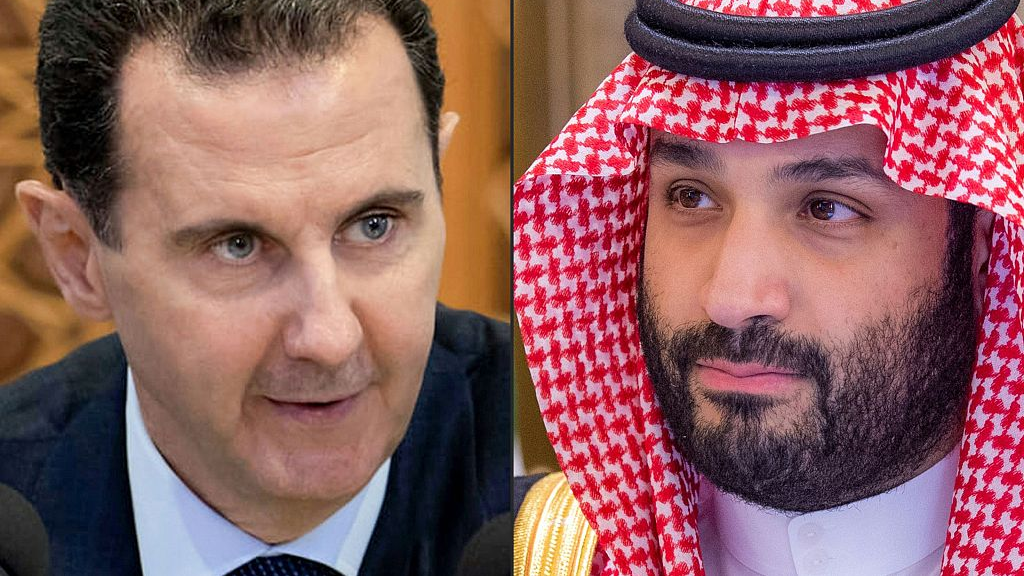
This combination of pictures shows a picture of Syrian President Bashar al-Assad (L) and a picture of Saudi Crown Prince and Prime Minister Mohammed bin Salman Al Saud. /CFP
This combination of pictures shows a picture of Syrian President Bashar al-Assad (L) and a picture of Saudi Crown Prince and Prime Minister Mohammed bin Salman Al Saud. /CFP
Editor's note: Hamzah Rifaat Hussain was a visiting fellow at the Stimson Center in Washington, D.C. He is also an assistant research associate at the Islamabad Policy Research Institute and specializes in conflict dynamics and foreign relations between countries. The article reflects the author's opinions and not necessarily those of CGTN.
The agreement by the Kingdom of Saudi Arabia and the Syrian Arab Republic to reopen embassies and resume diplomatic relations after mediation from Russia is another valuable addition to Middle Eastern stability and prospects for durable peace.
It stands in stark contrast to historical American policymaking in the region, which has been characterized by polarization, promoting divisions among states and the notable absence of mature diplomacy.
In 2023, both Riyadh and Damascus, which have been at loggerheads against each other over conflicting regional and domestic outlooks, are now slated to benefit from greater unity and revitalization in the absence of regional hegemony. This is precisely what is needed.
This rapprochement is supported by China with Foreign Ministry Spokesperson Mao Ning stating that Beijing unconditionally backs the strengthening of coordination by Arab states and their ability to exercise strategic independence, which is critical for regional development and stability.
For decades, the Middle East has witnessed the brazen erosion of its peaceful social, political and economic fabric due to reckless American interventions, heightened military presence and punitive operations which resulted in the destruction of Iraq after the U.S.-led invasion of Baghdad in 2003. Furthermore, the Syrian war in 2011 and American adamancy on regime change heightened Sunni-Shia proxy warfare and led to further deterioration of ties between two regional powers, Saudi Arabia and Iran. This rapprochement between Damascus and Riyadh defies American polarization.
Furthermore, since the 2003 invasion, more than 280,000 civilians died in the Iraq war while at least 929,000 civilians were killed from direct war violence in countries such as Syria and Yemen. Coupled with mass civilian casualties from U.S.-led wars are economic costs and pervasive poverty, which have plagued countries such as Syria in the region. Since the war started in 2011, the U.S. policy of regime change led to economic costs amounting to $1.2 trillion with damage to infrastructure alone costing $117.7 billion. These harrowing realities in the Middle East unfolded in the absence of dialogue, de-escalation and diplomacy from respective U.S. administrations and constitute an abject failure on the foreign policy front for Washington.
The planned revitalization of bilateral ties, however, comes at an opportune time. It unfolds straight after archrivals Iran and Saudi Arabia shelved decades of differences and agreed to end years of hostilities through a China-brokered deal. According to the Director of the Center for Middle Eastern Studies at Fudan University, Sun Degang, the normalization of relations between Riyadh and Tehran had a significant impact on the mitigation of relations between Syria and Arab states, including Saudi Arabia and the United Arab Emirates.
Encouraging signs for relations between the two states also came in January 2023 when the Assad government allowed the import of Saudi goods after a 10-year suspension in order to address a severe economic crisis caused by the decades-long war.
Additionally, Saudi Arabia along with China and Russia were among the first countries to aid Syria after the devastating 2023 earthquake. Humanitarian assistance to Damascus from China amounted to $4.38 million with 80 tons of medical supplies. This is in contrast to the United States, which is yet to lift sanctions on Syria and has stifled speedy rescue efforts.

Humanitarian aid relief packages provided by Saudi Arabia for victims of the earthquake in Syria are unloaded off of an Ilyushin Il-76TD transport aircraft at Aleppo International Airport in northern Syria on February 14, 2023.
Humanitarian aid relief packages provided by Saudi Arabia for victims of the earthquake in Syria are unloaded off of an Ilyushin Il-76TD transport aircraft at Aleppo International Airport in northern Syria on February 14, 2023.
This trend towards normalization in the Middle East clearly demonstrates that the U.S.-led historical regional order, which resulted in widened trust deficits, military confrontations and prolonged crises such as the Syrian war, has failed.
Yet, American defiance of reconciliation between Middle Eastern states continues despite the promising announcement of the thawing of Syria and Saudi Arabia relations. When questioned on the rapprochement, the U.S. State Department stated that Washington would not encourage other countries to normalize ties with the Syrian government. This reveals how the security and political establishment in the United States continues to opt for prolongation of the conflict and instigating regime change instead of opting for a political solution.
It is hence, critical for Middle Eastern states such as Syria and Saudi Arabia to resort to political solutions instead of bandwagoning with American foreign policy to avoid divisions and discord and promote regional connectivity, prosperity and strategic stability instead. Arab unity as exemplified in the Arab League should be carried forward.
At the first China-Arab States Summit in 2022, Chinese President Xi Jinping, while affirming the spirit of inclusiveness and joint mutual learning, stated that China supports the Arab side in promoting political settlements to challenging issues through Arab wisdom and building a comprehensive, cooperative and sustainable security architecture in the Middle East. This is only possible if states continue to establish diplomatic relations and govern affairs without outside interference.
The rapprochement between Syria and Saudi Arabia is encouraging and bodes well for Middle Eastern stability.
(If you want to contribute and have specific expertise, please contact us at opinions@cgtn.com. Follow @thouse_opinions on Twitter to discover the latest commentaries in the CGTN Opinion Section.)